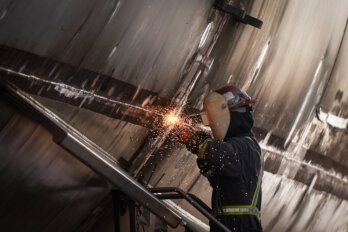In early October, a provincial by-election in Quebec’s Louis-Hébert riding sent a clear message to the Quebec Liberal Party that their popularity was fading. It only took results from a few early polls for reporters to announce that the Liberals would lose the seat. After almost fifteen years in office, the party, which has positioned itself as the enlightened and pragmatic flank of Quebec politics, appeared to be in trouble.
Though largely rural, Louis-Hébert also includes the suburban neighbourhoods Sainte-Foy and Cap-Rouge. It is hardly a safe riding for the Liberals. In 2007, Sam Hamad, an MNA first elected in 2003 with Jean Charest’s Liberal government, barely won. He resigned his position earlier this year, triggering the by-election.
The results were stunning. Coalition Avenir Québec’s Geneviève Guilbault won with more than 51 percent of the vote despite being a last-minute replacement candidate. Air Transat co-founder François Legault leads the CAQ, which has never been in government. If the Liberals are starting to wear out their welcome, it’s the CAQ, which sits to the far political right of the Liberals, that stands to gain the most.
The Liberals took their loss on the chin. With the next general election slated for fall 2018, the Liberals have already signalled that they’re gearing up for election mode. The CAQ victory tells many within the Quebec Liberal party that the CAQ, not the Parti Québécois, will be the party to beat. Liberals need to score quick political points, and what better way than to revive the niqab debate?
In 2015, provincial justice minister Stéphanie Vallée introduced the now infamous Bill 62. The proposed legislation would ban anyone who is giving or receiving a public service from wearing a face covering. In June of that year, Vallée told the National Assembly that the law wasn’t intended to target any single religion but rather to ensure that people could expect a certain level of religious neutrality when receiving public services. This summer, the Liberals sent the bill to committee. And then, using their majority at the National Assembly, the Liberals passed Bill 62 into law on October 17—two weeks after their loss in Louis-Hébert.
“I should see your face, and you should see mine,” Quebec premier Philippe Couillard told reporters. “It’s as simple as that.” Simple, particularly since the bill only really targets one group of people: the tiny minority of Muslim women who cover their face. It’s estimated that there are fewer than 150 women in all of Quebec who wear the niqab, and the estimate is likely higher than the actual number. It’s worth mentioning that the CAQ, the PQ, and Québec solidaire all voted against Bill 62, and the CAQ and PQ said they did so because the bill didn’t go far enough. The PQ now intends to present a bill “before Christmas” that would ban the niqab in all public places and impose harsher penalties for anyone who does wear the niqab while receiving or giving public services.
Vallée stresses that her government wants a person’s face to be shown any time they are interacting with someone. Getting on the bus, therefore, is classified as an act of communicating with a driver. However, riding the bus is not, so a person’s face can be re-covered after they’ve taken their seat. On close reading of the legislation itself, this doesn’t go much past the limits already established by the Supreme Court: for identification purposes, women can be asked to show their faces. But, says McGill law professor Daniel Weinstock, the Liberals have tried to make it look as if the bill does much more than that. It’s critical, he adds, to understand this rhetoric fits into “the short-term political chess game that is being played right now.”
The niqab is a favoured political football both inside Quebec and out. The NDP blamed their disappointing election outcome in 2015 in Quebec on the niqab debate, and some form of this kind of legislation has been bandied around Quebec’s National Assembly for years. During the eighteen months when the PQ was in government, from 2012 to 2014, the niqab played a prominent role in their push for the province to adopt what they called the Charter of Values. From the materials that the PQ used to promote their charter to the commitment to ensure that those accessing or administering public services could not wear a religious symbol, the niqab became synonymous with unreasonable accommodation in secular society. The PQ maybe went too far: their election loss in April 2014 was linked by many to their obsession with the values charter, among other factors.
In 2013, Couillard argued that the charter debate was deeply troubling and that the charter written by politicians who wanted to see Quebecers fight each other. Indeed, since 2014, the debate about secularism has become increasingly grotesque. This year alone, Quebecers have seen the rise of the extreme right in the province, the popularity of which has manifested both online and in public debates, and a deadly shooting at a mosque in Sainte-Foy. Hate crimes are routine in Quebec City: racist flyers are regularly circulated in suburban neighbourhoods and seeing racist stickers downtown is common. The way government has framed secularism is clearly giving oxygen to the extreme right; from their Facebook groups to their protests, far-right groups demonstrate that the arguments peddled by the Liberals about state religious neutrality directly feed their racist sentiments.
But even though Couillard criticized the values charter debate, he also promised to specifically address the face covering issue as premier. Bill 62 is that promise, fulfilled.
The CAQ has never shied away from fear mongering about Islam. For example, in August 2016 during a CAQ caucus meeting, Legault publicly mused about banning women from wearing “burkinis” and banning women police officers from wearing the hijab. “Imagine that tomorrow morning, a police officer wearing a hijab had to interact with a member of the Jewish faith,” he said in his opening remarks. He wasn’t responding to anything that had happened: it was simply August, and, apparently, talking about women who cover themselves up seemed like the right way to start the CAQ political year.
When it comes to voter intention across the province, says Weinstock, the CAQ is seemingly the second choice. With less than a year to go until the next election, he adds, the Liberals need to be seen as if they are chasing the same voters as the CAQ to have a chance of re-election. Those voters are the people who perceive the phantom accommodation requests of Muslims as going too far. It’s worth noting that the only high-profile niqab case in Quebec has been the same one as in the rest of Canada: Zunera Ishaq’s struggle to wear a niqab while taking her citizenship oath. There haven’t been any high-profile cases where a Quebecer who wears niqab has demanded any other accommodation.
The timing of Bill 62 becoming law cannot be untied from the proximity to the next general election, or the October 2 by-election loss in Louis-Hébert. Michel Matte and Patrick Huot, Liberal MNAs from ridings adjacent to Louis-Hébert argued that part of the reason their party lost was because it had just established a commission on systemic racism. Matte said that he didn’t think that the commission was a priority “for francophones…or for people in [the riding of Portneuf].” His statement had echoes of Legault, who has called the commission an “insult” to Quebecers. The Liberals have since removed the word “racism” from the commission’s title and severely restricted its mandate.
What makes this debate so explosive in Quebec is a combination of xenophobia and history. The vast majority of Quebecers will never encounter a niqab in their lifetimes (let alone get to know any women who actually wear one), and, like anywhere, ignorance fuels xenophobia. But there is also a very real and recent history that many Quebecers live with. For more than a century, nuns in full habit imposed Catholic rule on children, especially through corporal punishment and abuse, in the province’s schools. It’s more likely than not that Quebecers older than forty live with these experiences. Any outward religious symbol harkens back to the days where public services were doled out by a controlling, aggressive, and oppressive church.
But to make Muslim women who wear niqab the enemy is to exploit and distort this common experience, using trauma that many people still carry to subjugate and oppress a small minority of Quebecers. It’s by intention that no one is talking about removing the thousands of crucifixes that dot Quebec’s landscape and that still adorn public schools and hospitals or the names of obscure saints, whose identities no longer matter, who live on as a location point on a map. Many call this phenomenon “catho-laïque” a compound word that reminds us that secularism isn’t really secular if it remains rooted in a Catholic norm.
Weinstock warns that the rhetoric surrounding the bill is what is most concerning: “That is the danger; that this will create licence to marginalize, stigmatize, and verbally abuse Muslims wearing niqab and maybe also Muslims wearing hijab,” he says, adding that using these tactics as a way to win an election is “inexcusable.”
On the morning of October 24, Quebecers woke up to surprising news: the Liberals had won a federal by-election in the riding of Lac-Saint-Jean. It’s the first time that the Liberals have held the riding since 1980. They’d knocked out the Conservatives, who had long held the seat after many years of Bloc Québécois representation. Justin Trudeau’s tepid reaction to Bill 62, seen through the lens of this by-election, makes a lot of sense: the federal and provincial parties are separate beasts, but it still helps the federal Liberals if they, at least, don’t condemn the provincial Liberals’ bills. The NDP came in a distant third with less than 12 percent of the vote. Just two years ago, Gisèlle Dallaire, the same NDP candidate, came in second, with 28.6 percent of the vote.
This significant drop poses another important question: Did the religious-symbols debate influence voters away from the NDP, and did Jagmeet Singh’s turban play a role in the minds of electors? A drop of this magnitude for the NDP in just two years is significant. There are many factors that have lead to a decline in the popularity of the NDP, but a culture of suspicion of individuals who wear religious symbols is, clearly, going to make things harder for a politician who wears a religious symbol. This is where the dangerous game of the Quebec Liberals is most evident: when you exploit xenophobia in your political strategy, you feed into the rise of xenophobic populism.
But the game is zero-sum and will always go sideways. If a party embraces racism and xenophobia as a political strategy to help win an election, their opponents can also use the same tactics to ensure their own win. Caught in the middle are Quebecers who will never be white enough, always be suspicious, and never truly Québécois. Weinstock warns that the political context is already toxic. “People are waiting for an excuse to scream at a woman wearing niqab in a waiting room or on a bus,” he says. Rather than refusing to play into this dangerous political game, the Liberals are effectively bystanders to racist abuse—bystanders who could intervene but would rather stand back and watch instead.





